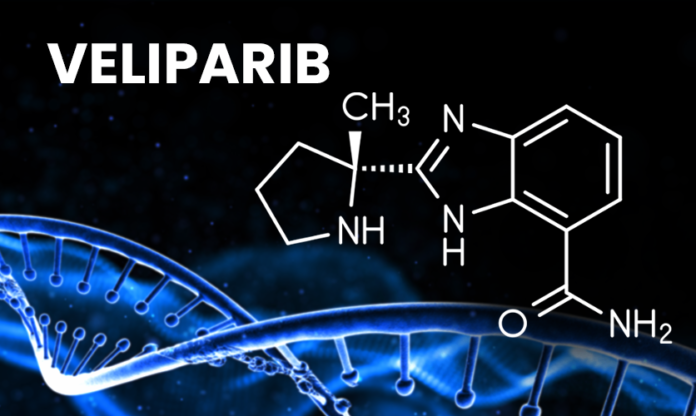A PARP inhibitor, Veliparib is an anti-cancer drug. In addition to blocking a protein called PARP, it also makes cancer cells more susceptible to anticancer treatments by preventing DNA or genetic damage from being repaired. As a result of Veliparib, whole-brain radiation may work better against NSCLC brain metastases. Several combination clinical trials have used it to enhance the effects of many chemotherapeutics.
Table of Contents
What is Veliparib?
Veliparib, an oral PARP-1, and PARP-2 inhibitor, also shows promising results in treating recurrent ovarian cancer. So far, this agent has been most successful in combining with cytotoxic agents compared to other PARP inhibitors. According to the results of a phase 2 study of veliparib as a single agent, 26% of ovarian cancer patients treated with the drug responded to it. Some hematologic toxicities were observed, with modest adverse events expected. Cytotoxic chemotherapy may benefit from veliparib, but it is unclear what benefit it may offer. When cyclophosphamide alone was compared to cyclophosphamide plus veliparib, the randomized phase II trial found no additional benefit in response rates of the active pharma ingredients.
Use of Veliparib
In nanomolar concentrations, veliparib (ABT-888) inhibits PARP1 and PARP2. It has been shown to cross the blood-brain barrier and has good bioavailability. Several platinum-based therapies, cyclophosphamide, radiation, and temzolomide, are potentiated by veliparib in preclinical syngeneic and xenograft models.
In the early stages of clinical trials, Veliparib api has been combined with cytotoxic chemotherapy in most cases, including the I-SPY2 breast cancer trial, which evaluated veliparib and carboplatin in triple-negative breast cancer patients with objective responses]. Veliparib’s low PARP trapping activity may explain its ability to combine with chemotherapy.
Side Effects of Veliparib
As a result of the study presented at the Society of Gynecologic Oncology Annual Meeting on Women’s Cancer in Tampa, Florida, veliparib demonstrated activity with acceptable toxicity among women with recurrent or persistent epithelial, ovarian, peritoneal and fallopian tube cancers with BRCA1 or BRCA2 mutations.
In total, 26% of patients responded to the chemotherapy, of whom one complete response and 12 partial responses were recorded. Researchers found that more platinum-sensitive patients (35% of patients) responded to the chemotherapy than platinum-resistant patients (20%).
Among patients who discontinued treatment (46%), the progression of disease was the most common reason. Twenty-four (28% of the patients) had their doses reduced due to toxicity.
Among the most common veliparib side effects were nausea (46%), fatigue (26%), vomiting (16%), and anemia (14%). Researchers reported one case of grade 4 thrombocytopenia, one case of grade 3 leukopenia, one case of neutropenia, one case of dehydration, and one case of grade 3 thrombocytopenia. Two patients experienced grade 3 fatigue, and three had grade 3 nausea.
Patient Inclusions for Veliparib
Inclusion Criteria:
- Stage III or IV epithelial ovarian, fallopian tube, or primary peritoneal carcinoma, according to the International Federation of Gynecology and Obstetrics (FIGO), with appropriate tissue available for histological testing.
- Adenocarcinoma of high grade
- A willing participant in a gBRCA test.
- The function of the hematology, renal system, and liver is adequate.
- Sensory and motor neuropathy of Grade 1 or less.
- Performance status 0 or 1 of the Eastern Cooperative Oncology Group (ECOG).
- For participants who undergo primary cytoreductive surgery, admission must be between one and twelve weeks after surgery. For participants undergoing interval surgery, admission must be before histological confirmation of the diagnosis.
- A participant may have cancer-related symptoms or not. Participants can have measurable diseases or non-measurable diseases.
- To perform pharmacodynamic analyses, including somatic BRCA testing, a specimen of either archival formalin-fixed paraffin-embedded (FFPE) tumor tissue or a tissue biopsy taken before Cycle 1 Day 1 must be available.
Exclusion Criteria:
- The most common type of adenocarcinoma is endometrioid adenocarcinoma, followed by carcinosarcoma, mixed epithelial adenocarcinoma, mucinous adenocarcinoma, clear cell adenocarcinoma, and low-grade serous adenocarcinoma.
- No vascular or lymphatic invasion, poorly differentiated subtypes of endometrial cancer such as serous, clear cell, or FIGO grade 3 lesions, no synchronous primary endometrial cancer, or a history of endometrial cancer.
- A participant with any evidence of other invasive malignancy within the last 3 years is excluded from participating (except non-melanoma skin cancer). A participant whose previous cancer treatment is contraindicated by the protocol’s treatment is also excluded.
- Previously undergone abdominal or pelvic radiotherapy.
- Previously undergone chemotherapy for a tumor in the abdomen or pelvis.
- Uncontrolled conditions that are clinically significant.
- Allergy or contraindication to Cremophor-paclitaxel, carboplatin, yellow colorant Tartrazine (also known as E102), orange colorant Yellow-S (also known as E110) or any compound supplied by active pharmaceutical ingredient manufacturers.
- An indication of CNS disease at the physical examination, including primary brain tumors, brain metastases, or history of cerebrovascular accident (CVA), stroke, or transient ischemic attack (TIA) within six months of Cycle 1 Day 1.
Conclusion
Veliparib is currently being developed as a single agent and in combination trials. Due to its modest hematopoietic toxicity, it is well-suited for combination trials. In the first phase, I/II trial of veliparib, patients with wild-type BRCA basal-like breast cancer and germline BRCA-mutated ovarian cancer were tested for a response. BRCA-mutated patients showed greater clinical activity with veliparib than patients with wild-type diseases. Veliparib by an api manufacturer was found to have a favorable toxicity profile. To learn more about the drug, reach out to us.


